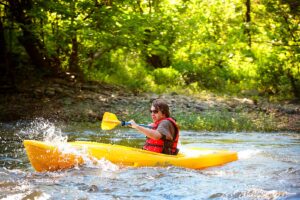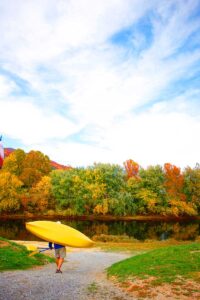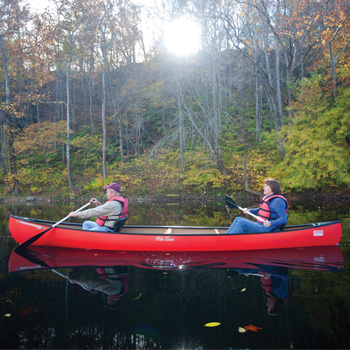
 Safety
Safety
Some basic things to know before getting out on the water:
Know the river levels.
If the water is flooded, low, or normal. A flooded river is often dangerous and should be avoided. A low river may expose logs, stumps or rocks, which make the trip slower and more difficult.
Realtime Water Levels for the James River in Buchanan >
Realtime Water Levels for the Maury River in Buena Vista >
Always wear a life jacket while boating.
Take the time to become familiar with your jacket. Test it in the water to make sure it supports your body and keeps your mouth and head clear of the water with no effort on your part. Try putting it on once you’re in the water…it’s not as easy as it seems.
Drinking and paddling don’t mix.
Avoid alcohol, which impairs the coordination and balance you need to control your boat on the river. Boating and alcohol don’t mix – public display and consumption of alcohol on river is also illegal. Save the drinks for after you get safely off the river.
Understand how rapids are classified.
River classification is used to give a universal language to describe the difficulties on a river.
It is a somewhat subjective guideline, and is based on judging a river under certain conditions (i.e. normal water levels). Even minor changes in water levels can completely alter a classification.
- Class I (easy): Easy moving water with riffles and small waves. Risk is slight; most can do this on their own with little instruction. Self rescue is easy.
 Class II (novice / moderate): Straightforward rapids with wide, clear channels which are evident without scouting. Rocks or obstructions are easily missed with minimum maneuvering by trained paddlers. Swimmers are seldom injured and group assistance, while helpful, is seldom needed.
Class II (novice / moderate): Straightforward rapids with wide, clear channels which are evident without scouting. Rocks or obstructions are easily missed with minimum maneuvering by trained paddlers. Swimmers are seldom injured and group assistance, while helpful, is seldom needed.- Class III (intermediate / difficult): Rapids with moderate, irregular waves which may be difficult to avoid and can swamp an open canoe. Complex maneuvering is required to avoid capsizing. Most danger can be avoided by experienced paddlers. Scouting is advised for inexperienced paddlers. Strong currents can make self-rescue difficult. Injuries while swimming are rare and self-rescue is usually easy, but group assistance may be required to avoid long swims.
- Class IV (advanced): Powerful, but predictable rapids. Requires precise handling in turbulent waters. May have large unavoidable waves or rapids. Constricted passage may demand very quick maneuvering. Rapids may flip a raft. Swims may be long and violent. Risk of injury is a great possibility. Assistance is usually required if capsized. Group assistance for rescue is often essential and requires practiced skills. A strong eskimo roll is highly recommended for kayakers. Considered the limit for open canoes.
Know the river section you are floating.
Know where your float trip will take you and where to get out. Obtain a river map of the section of river you will be paddling so you will know what to expect. Plan your trip so you will always be off the river before sunset. Be prepared for the difficulty of the river section you are about to paddle. Paddle water appropriate to your skills. If you are a novice, paddle with a friend that has experience, or contact a local outfitter for your first trip.
Stay low and balanced in your boat.
Learn how to enter and exit your boat safely and stay low (kneel) in you boat when possible. Most paddle sports-related drownings are the result of capsizing. Don’t overload your boat. Secure gear evenly. If you do fall out or capsize, keep your feet pointed downstream and keep them off the bottom to avoid getting snagged or stuck. Stay upstream of your boat to avoid getting pinned between it and a rock or log. When you are able, swim to shore to re-enter your boat. If you’re paddling with a group, another boat may be able to assist you with righting and re-entering your canoe or kayak.
Know the weather forecast.
Check weather conditions forecast before launching your canoe/kayak (don’t go if the weather is beyond the abilities of the least experienced person in your group). Avoid paddling in cold weather. Stay alert to changing weather conditions while paddling. Get off of the water during electrical (lightning) storms.
Don’t get left in the cold.
A good rule of thumb is not to paddle when the combined air and water temperature is less than 110 degrees. Dress for the day and be prepared to get wet. Meaning, if the weather is cool, dress warm and bring an extra set of dry cloths sealed in a dry bag for emergency use.
 Never paddle alone.
Never paddle alone.
Companions can come to your aid if you get in trouble. New paddlers should paddle with some one more experienced; it’s a great way to learn and remain safe if there is a mishap. File a “float plan” with a relative or friend so that someone knows where to find you and when you plan to return.
Learn to control the boat.
Be able to stop the boat at any time and know how to land on shore. Know how to boat forward, back, and sideways using paddle strokes in various water conditions. Consider taking a canoe or kayak paddling class.
Learn to recognize river hazards.
Be able to recognize river hazards such as submerged rocks, strainers (downed trees or branches reaching into the water); bridge pilings, big drop-offs, large waves, man made obstacles or debris, barbed wires across rivers, etc. Know how to safely navigate or portage around these hazards.
Respect private property.
Virtually all of the land along the river bank is private property. Land only on public areas, or where you have permission to be.
 Pack out all trash.
Pack out all trash.
Follow “Leave No Trace Ethic”. Don’t take glass bottles on the river, as they can break and create a hazard for another paddler. Take along a trash bag and help us keep the river clean.
Don’t paddle in high water.
The recommended high water cut off for the Upper James River Water Trail is 6 foot on the Buchanan, VA USGS river gauge. Online river gauge information. Be cognizant of rain received in the watershed up river which can take hours or days to flow through the Upper James River Water Trail.
Be Green.
Enjoy the ecology in the natural state that it is in and let others enjoy it, too.
Know when to call it a day.
The Water Trail closes at dusk as it is unsafe to navigate rapids at night.
Don’t leave home without it.
In addition to your canoe or kayak, paddles, and life jackets we recommend you bring the following:
 Dress for a day on the river. Most folks wear bathing suits, shorts, tee shirts.
Dress for a day on the river. Most folks wear bathing suits, shorts, tee shirts.- Wear shoes, old gym shoes sandals with ankle straps work great
- River map
- Sunscreen / Lip balm
- Plenty of non-alcoholic beverages
- Food depending on length of trip
- Sun hat / sun glasses with strap
- Cell phone in dry box (coverage is typically good in most sections of the river).
- Bailer / pump or / sponge to remove water from boat
- Trash bag for any garbage you create
- Optional – Fishing pole, bait, tackle, & license.





 Safety
Safety





